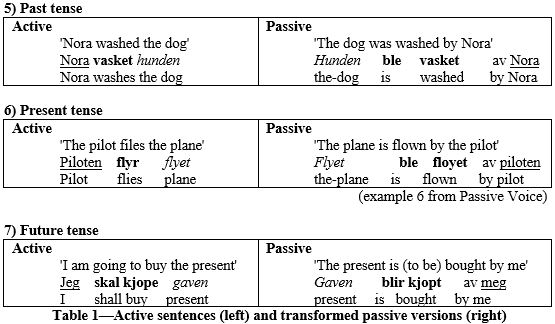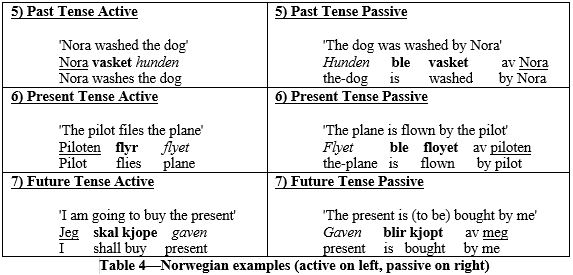There Was Gesticulated? What Norwegian Passives Inform Us about Meaning and Structure
by Jill McLendon, with contributions from Lindsey Todd and Emma Mainer, Linguistics
This paper explores the relationship between word order (syntax) and meaning (semantics) through the application of theta-theory to Norwegian passive transformations. In syntactic analysis, it is important to separate the information given by the position of words in a sentence from their meanings in those positions. This distinction is observable in the prevalence of passive sentences in news and academic papers, where journalists highlight events but often the cause is unknown. Passive sentences are believed to result from moving phrases from their original locations in an active sentence. Under this view, “the paper was written by him” would have the underlying active structure “he wrote the paper.” This project seeks to answer how meaning is retained through this process when phrases are moved from their original positions. It explains the difference between structural features, called cases, and semantic features, called theta-roles, that describe meaningful relationships. As theta-roles are assigned to words independently of their order, they represent the same information across different languages, unlike syntactic rules. To illustrate how theta-roles account for the maintenance of meaning despite transformations, this paper explores passivization in Norwegian (Bokmål) using Haegeman’s theta-role list (2001), concluding by showing how case-assignment and theta-role assignment are separate processes.
passive, Norwegian, syntax, semantics, case-assignment, theta-role
How Passive Works
In both spoken and written language, passive sentences are common phenomena that speakers encounter daily. These constructions show up in languages as a way to highlight the fact that an event or idea occurred, but without requiring that speakers specify what was responsible for the event, notably used in writing styles like journalism and academic writing. In syntactic theory, passives are not actually the base version of sentences but the outcome of a variety of movement processes that happen to an active sentence underlying the passive one. These movements are what allow for the option to specify the person or thing responsible for an event. The contrast can be seen in sentences (2) and (3) below:
1. The cat ate tuna.
Passive Options:
2. The tuna was eaten by the cat.
3. The tuna was eaten.
Sentence 1 is considered to be the original, or most basic, version of the passive versions that follow in (2) and (3). This original version corresponds to a sentence’s deep-structure, the structure that most closely approximates the way the sentence is organized mentally in the brain. Deep-structures are like skeletons, on top of which muscles and skin can be added. Arguably, it is at this deep structure that sentences are transformed from active (1) to their passive counterparts (2-3).
A good way to examine how this passivization process works is to do what syntacticians love to do when testing out new theories: throw it at a bunch of foreign languages and see if it sticks! This paper does exactly that, using an analysis of how to make passive sentences in Norwegian, and concluding with the theories that explain the issues just given above.
Across different languages, there seem to be patterns to how passive sentences are made from their deep-structures. For some reason, they seem to involve similar processes of what bundle of words goes where. In the case of English, this is apparent when looking at where words end up in the passive versions of the sentence about the cat eating its meal. First, here’s a parse of the original deep-structure so the comparisons are clear:
1)
[The cat] ate [tuna].
[Subject] Verb [object].
Noun Phrase Predicate
Now that the parts of the sentence have been explained, it should be clearer to see what actually happens in sentences (2) and (3):
2)
[The tuna] was eaten by [the cat].
[Subject] Verb Preposition [object of preposition]
Noun Phrase Predicate
Sentence three undergoes the same process, but it just leaves the prepositional phrase off:
3)
[The tuna] was eaten.
[Subject] Verb
Noun Phrase Predicate
Notice how in both (2) and (3) the subject, the cat moves to the end of the sentence, and the object, tuna, is moved to the place that the subject left empty. The most important realization to make here is that the passive variation of an active sentence still retains the same meaning as the active meaning, just highlighting a different group of words by placing it first. This is why the deep-structure is the same for both (2) and (3).
Fortunately, for pattern-loving syntacticians, the same pattern of movement just explained above, where the subject moves to the end of the sentence and the object moves to the subject position, can be seen across many world languages. In the abstract, the processes that generate, or allow, passive structures to result from an original deep-structure can be described formally in a transformation rule:
English Passivization Rule:
0) Start with an active sentence.
1) Add something new to it that says the sentence is passive:
-could be a whole word inserted into the sentence like was
-could be marked on the verb itself by an ending (inflection)
2) Demotion of subject
-often fits into a prepositional phrase roughly equivalent to English by __
-could be marked on the subject by an ending (case)
3) Promotion of object
-usually becomes the subject where any markings necessary are added (case)
4) Pronounce the passive sentence
If these generalizations work cross-linguistically, there should be no issue with taking a random active sentence floating around in the brain and passivizing it, no matter what language. While it can be a little more complicated than that, these rules do tend to apply cross-linguistically, and different languages have different restrictions on what types of sentences can be turned passive. In English for example, there are situations in which trying to make a passive sentence from an active one just makes no sense. What if there isn’t an object in the active sentence, as in The cat is purple? What if the sentence has no meaningful subject: It rains? Further, and most importantly, how come the meanings of two different sentences, with completely different words as the subjects and prepositional objects, are still the same? Surely a word being a subject or object gives it a different purpose in the sentence. A clear way to examine this process is to see it pointed out clearly in other languages that mark this process explicitly.
Meet Norwegian
Norwegian is a North Germanic language spoken in Norway, making it a distant cousin to English as both are in the German branch of European languages (Britannica). Words tend to go in the same order, except that it requires a verb as the second word, in V2 position like German. Like English, it puts its subjects first, followed by its verbs (SVO, or subject-verb-object; (“Sentence syntax”)). While there are two major writing systems in use in Norwegian–Bokmål ‘book language’ and Nynorsk ‘New Norwegian’–this paper uses Bokmål as it is the dominant writing form used by 85-90% of the population (Husby). While linguistic analysis of Norwegian is not new, Norwegian was chosen for this paper because the grammar makes clearer distinctions between theta-roles and case-assignment than can be seen in English, particularly in the passive.
How Passive Works in Norwegian
A good way to start with the Norwegian passivization process is to look at a bunch of passive sentences in Norwegian and find patterns.

Table 1. Active vs Passive Norwegian Examples 5-7.
In all of these sentences, the similarities between making passive sentences in English and Norwegian are readily apparent. Subjects are underlined, direct objects are italicized, and verbs are in bold. Even in Norwegian, the same switch of positions takes place, with subject demotion and object promotion. Just like in English, Norwegian also likes to indicate when its sentences are passive, using a special word that marks it, bli. This bli is like the English was, in “lunch was eaten”, and it occurs at the start of every verb phrase. Making passives in Norwegian is the exact same as what has been shown for English, just with an agreement difference in the present tense. This whole paragraph can be simplified by establishing a formalized rule for how passive works:
Norwegian Passivization Rule:
1) Take a sentence and put the subject into a prepositional phrase starting with av at the end of the sentence.
2) Put the object of the sentence into the subject position.
3) Add the word bli or blir immediately before the main verb.
4) Pronounce the passive sentence
Based the elementary data explored so far, the passive rule seems straightforward. Now the questions from before can be revisited: 1) Can all sentences be turned into passive sentences? and 2) How do two different sentences mean the same thing?
To address the first question, consider all of the Norwegian examples used here.

Table 2. Active Norwegian Examples Juxtaposed 5-7.
With all of these sentences listed together, an immediate patterns jumps out. Both subjects (underlined) and objects (italics) show up, and in each sentence, they are on the same sides of the verbs (bold). Each sentence has a subject, in nominative (nom) case, and at least one object, in accusative (acc) case. These sentences can be passivized easily thanks to the fact that they have subjects and objects, and this pattern is observable in English as well. In fact, the only active sentences in English that can be passivized are those that have at least one subject and one object. The subject and object phrases are each assigned an appropriate case (nominative to subjects, accusatives to objects) and can move around as needed, such as during passivization. On the other hand, what about sentences that lack either a subject or object, or both? The constraints on grammatical rules like passivization become readily apparent when deliberately broken, such as in the active sentences below:
8) It rains.
9) I sleep.
Both sentences 8 and 9 have a subject and verb, but some information is missing that affects whether these can be passivized. In sentence 8, the subject it has no meaning, instead serving as an empty place-holder (what is it that happens to be raining?). Because the subject is empty, there’s no implication that something or someone is actually doing the ‘raining’. In both sentences, the object is missing. Nothing is being ‘rained’ in sentence 8, and while sentence 9 does have a meaningful subject, nothing is available that could be ‘slept’. There is no object to be ‘slept’, so nothing can be moved to the subject position. If this were attempted, a funny structure would result that sounds something like:
9A) *My cat is slept by me.
The fact that 9A sounds so weird evidences that requirements exist when considering what can be made passive, at least in English. The problem with 8 is the meaning of the subject, and in 9 with the meaning of the verb. In English, then, making a sentence passive requires a sentence with the right meaning and structure, which entails at least a subject and an object. Such types of restrictions exist in other languages, including Norwegian, but the nature of the restrictions might be different. For example, while English does not allow active sentences without objects to be passivized, Norwegian does allow this, because it can replace the missing object in such a construction with what is called an impersonal subject, in English roughly approximated by ‘there is x occurring’. This means that passivization in Norwegian only requires a subject to form the passive, and as seen in the examples below:
(3) a. Active: Han synger. Passive: Det vart sunge.
‘he sings’ ‘there was sung’
b. Active: Gestikulerte han Passive: Det vart gestikulert.
‘Gesticulated he’ ‘there was gesticulated’
(Åfarli 1989)
The existence of these restrictions answers the final question: why does passivization not change the meaning of a sentence? The answer lies in differentiating between the meaning of a sentence, its semantics, and the order of words in a sentence, its syntax. A process like making a passive sentence from an active one only acts on the syntax, which allows other information in the sentence to be free to hold the meaning constant. This suggests that the syntax is less strictly defined, or can move more, than the meaning relationship. In syntactic theory, the information that encodes these meaning relationships is encapsulated by abstract labels called theta-roles (θ-roles).
The Role of Theta-Roles in Passives
Case-assignments have already been mentioned in brief as one layer of positionally-dependent labels given to subjects and objects. Theta-roles differ from cases in that they describe aspects of the meaning of a specific phrase, such as whether it experiences something like sleeping or tasting a food. Some tend to show up often in subject position, like the doer or agent role, that describes something with volition and ability to do something. In active sentences, roles that show up in object position often will be assigned the theme or patient role, as objects are undergoing the action of the verb. There are other roles that the subjects and objects can take, however, and this is an important point that explains why syntax need not strictly determine meaning.

Table 3. Theta Grid English Example.
In the table above, the meaning of I, the agent, is related to the ball by the verb, which shows how the subject and object relate meaningfully to each other–in this case by the ‘kicks’ action. Like how the syntax of major parts of a sentence is represented abstractly by cases, theta-roles map relations between the meanings of phrases. Like cases, they are features that are also given to phrases, but the way cases are assigned depends only upon a phrase being in the correct syntactic position, not on the meaning of the phrase. Ultimately, this allows syntactic cases to show up on whatever phrase ends up in the location where it could get that case, so case-assigning positions are more static and less likely to move.
Notice in the chart below that even in the passive variants of the Norwegian sentences, the subjects (underlined), or nominatives, are always at the start of the sentence. This is because the syntactic structure of Norwegian defines the order in which subjects, verbs, and objects will show up: SVO. Theta-roles, on the other hand, ignore this order entirely as they are given to phrases at deep-structure, before movement occur that generate the final SVO structure. Once assigned to a phrase, then, theta-roles stick onto the phrase even if phrase (and thus case-markings) move elsewhere. From this, it can be seen that case–marking and theta-role assignment are independent of each other.

Table 4. Active vs. Passive Columned Comparison.
In these sentences, the theta-roles assigned to each phrase are kept constant in both active and passive versions. In sentence 5, for example, ‘hunden’ (italicized), is always the theme, or undergoer of the washing, even when it shows up in subject position in passive where it obtains nominative case. Likewise, in both the active and passive versions, Nora is still the person initiating the washing of the dog.
Overall then, Norwegian grammar provides a clear example of what processes actually go on under the surface of passive sentences, especially in comparison to English that has broader restrictions that obscure some of these details. During a passive transformation, phrases are assigned a theta-role at deep-structure, so that when these phrases move later to generate the correct syntax, they carry their theta-roles with them. It is only until phrases and their theta-roles are finished moving into their passive destinations that case-assignment happens, and this difference in the order of label assignments reflects how the meaning of phrases (represented by theta-roles) is separate from the structure (indicated by case-marking after movement). Compared to English, Norwegian shows the details of this passivization process very clearly, because it allows passivization of some types of sentences without objects. In Norwegian, this can happen without objects because the correct meanings that are required for passivization are still assigned by the correct theta-roles before the structural order is defined by movements afterward. Even if some of the phrases like the agent are dropped during the passive transformation, the theta-role is still assigned, so the meaning requirements in the deep-structure are still satisfied. Contrasting Norwegian and English this way clarifies how the assignment of meaning (through theta-roles) does not rely on order or position (case-assignment), and overall provides more insight into the operations underlying human communication.
References
Åfarli, Tor A. (1989). Passive in Norwegian and in English. Linguistic Inquiry, 20(1), 101–108. http://www.jstor.org/stable/4178615
Britannica, T. Editors of Encyclopaedia (2023, May 26). Norwegian language. Encyclopedia Britannica. https://www.britannica.com/topic/Norwegian-language
contributors, N. (n.d.). Passive Voice. Norwegian Language Learning. https://norwegianlanguagelearning.no/post/passive-voice/
Haegeman, L. (2001). Introduction to Government and Binding Theory. Blackwell.
Husby, O. (2010, October). The Norwegian language. NTNU. https://www.ntnu.edu/now/intro/background-norwegian.
Sentence syntax – norwegian. TypeCraft. (n.d.). https://typecraft.org/tc2wiki/Sentence_syntax_-_Norwegian.
Acknowledgments
The author extends thanks to her teaching assistant, Jean Costa-Silva ABD and his teaching assistant Michael Wolfman for their inspiring instruction in generative syntax as well as professional insights into the field and pointed advice during the drafting stage of this essay. Further, Dr. Lee-Schoenfeld helped with the editing process proving valuable expertise.
Contributions
This article was authored Jill McLendon based on a midterm group project that served as the theoretical foundation for this project. The other members of the class group were:
- Lindsey Todd: Norwegian sentences, glosses and theoretical research.
- Emma Mainer: initial formatting, proofing, and theoretical research.
Citation Style: APA
